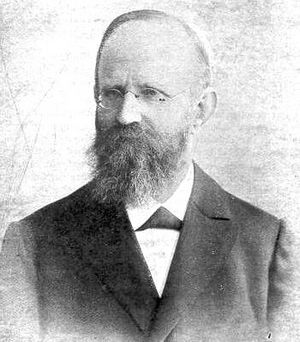Friedrich Robert Helmert facts for kids
Quick facts for kids
Friedrich Robert Helmert
|
|
|---|---|

Professor Friedrich Robert Helmert. Photographer unknown.
|
|
| Born | 31 July 1843 |
| Died | 15 June 1917 (aged 73) |
| Nationality | German |
| Alma mater | Polytechnische Schule, now Technische Universität, in Dresden, University of Leipzig |
| Known for | contribution into geodesy and theory of errors. |
| Awards | recipient of some 25 German and foreign decorations |
| Scientific career | |
| Fields | Mathematics, geodesy |
| Institutions | Technical University in Aachen, University of Berlin. |
Friedrich Robert Helmert (born July 31, 1843 – died June 15, 1917) was a brilliant German scientist. He was a geodesist, which means he studied the Earth's shape and size. He was also a statistician, someone who works with data and numbers. Helmert made big discoveries in understanding and dealing with errors in measurements.
Contents
Early Life and Studies
Friedrich Robert Helmert was born in Freiberg, Germany. After finishing school in Freiberg and Dresden, he went to the Polytechnische Schule in Dresden in 1859. This school is now known as Technische Universität. He studied engineering science there.
One of his teachers, Christian August Nagel, noticed Helmert's strong interest in geodesy. Geodesy is the science of measuring and understanding the Earth's shape, size, and gravity. While still a student, Helmert was hired by Nagel. He helped with a project to map the Ore Mountains using a method called triangulation. This method uses triangles to measure distances and positions.
In 1863, Helmert became Nagel's assistant. They worked together on a project to measure the Earth's curved surface in Central Europe. After studying mathematics and astronomy for a year, Helmert earned his doctor's degree in 1867. He got this degree from the University of Leipzig. His work with Nagel formed the basis of his important research paper.
Becoming a Professor
In 1870, Helmert started teaching at RWTH Aachen. This was a new technical university in Aachen, Germany. By 1872, he became a full professor there.
While at Aachen, he wrote a very important book. It was called Die mathematischen und physikalischen Theorieen der höheren Geodäsie. The first part came out in 1880, and the second part in 1884. This book became a key text for modern geodesy. It explained how to solve complex problems about the Earth's shape. For example, it showed how to find the shortest path between two points on a curved surface like the Earth.
Contributions to Statistics
Helmert also made big contributions to the field of statistics. A method called least squares was used in geodesy by a famous mathematician named Carl Friedrich Gauss. This method helps find the "best fit" line or curve for a set of data points.
Helmert wrote an excellent book about the least squares method in 1872. It became a standard textbook for many years. A second edition was published in 1907.
In 1876, Helmert made an important discovery. He found the chi-squared distribution. This is a special way to understand how much the measurements in a sample vary from the average. This discovery was written about in German textbooks. However, it was not well known in English-speaking countries. Because of this, other scientists later rediscovered it. For example, Karl Pearson found the chi-squared distribution again in 1900. Other scientists like 'Student' (William Sealey Gosset) and Ronald Fisher also rediscovered its use for understanding sample variation.
Later Career and Legacy
From 1887, Helmert was a professor at the University of Berlin. He taught advanced geodesy there. He also became the director of the Geodetic Institute. This institute was a leading center for studying the Earth's shape and measurements.
In 1916, Helmert had a stroke. He passed away the following year, on June 15, 1917, in Potsdam.
Honours and Recognition
Friedrich Robert Helmert received many awards and honours for his work. He was the president of a global organization for geodesy called "Internationale Erdmessung." He was also a member of the Prussian Academy of Sciences in Berlin. In 1905, he was chosen as a member of the Royal Swedish Academy of Sciences. He received about 25 different awards and decorations from Germany and other countries.
To honour his contributions, a crater on the Moon was named Helmert after him. The International Astronomical Union approved this name in 1973.
See also
- Coordinate system
- Gauss–Helmert model
- Geodesics on an ellipsoid
- Helmert's equation
- Helmert transformation (in geodesy)
- Helmert–Wolf blocking
- National survey
- Terrestrial gravity field


